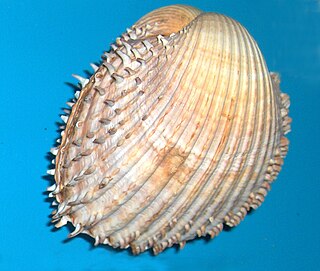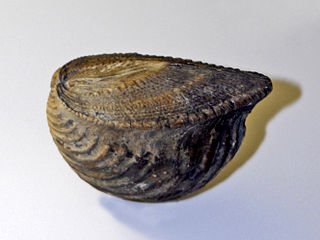
Goniatites is a genus of extinct cephalopods belonging to the family Goniatitidae, included in the superfamily Goniatitaceae. Hibernicoceras and Hypergoniatites are among related genera.

Pantolambda is an extinct genus of Paleocene pantodont mammal. Pantolambda lived during the middle Paleocene, and has been found both in Asia and North America.
Palaeothunnus is an extinct genus of prehistoric tuna that lived during the Thanetian stage of the Paleocene epoch.
Siganopygaeus is an extinct genus of prehistoric bony fish that lived during the Thanetian stage of the Paleocene epoch. It has been placed in the perciform family Siganidae.
Palaeopercichthys is an extinct genus of prehistoric bony fish that lived during the Thanetian stage of the Paleocene epoch.
Landanichthys is an extinct genus of prehistoric bony fish that lived during the Danian stage of the Paleocene epoch.
Eokrefftia is an extinct genus of prehistoric ray-finned fish that lived during the Paleocene epoch.

Calycoceras is an extinct genus of cephalopods belonging to the subclass Ammonoidea and family Acanthoceratidae that lived during the Cenomanian stage of the Late Cretaceous, 100-94 Mya. Their shells had ornate ribs.

Requienia is an extinct genus of fossil saltwater clam, a marine bivalve molluscs in the order Hippuritida, family Requieniidae. These rudists lived in the Cretaceous period, from the Valanginian age (136.4–140.2) to the Campanian age. They were stationary intermediate-level suspension feeders.

Strophomena is a genus of brachiopods belonging to the order Strophomenida family Strophomenidae, named by Rafinesque in 1824. They were stationary epifaunal suspension feeders.

Ampullinopsis is an extinct taxonomic genus of deep-water sea snails, marine gastropod molluscs in the clade Sorbeoconcha. These sea snails were epifaunal grazers. Sea snails of this genus lived from Paleocene epoch to Miocene epoch.

Acanthocardia is a genus of saltwater clams, marine bivalve molluscs in the family Cardiidae. They are infaunal suspension feeders.

Panenka is a genus of fossil saltwater clams, marine bivalve molluscs in the family Praecardiidae. Like most bivalves, these molluscs were suspension feeders. They lived in the Devonian Period.

Adocus is an extinct genus of aquatic turtles belonging to the family Adocidae.

Buxolestes is an extinct genus of semi-aquatic, non-placental eutherian mammals belonging to the family Pantolestidae. Species in this genus were part of the first placental evolutionary radiation during the Middle Eocene and found in the Bracklesham Group and Wittering Formation of England, at the Messel Pit in Germany and in Bouxwiller, France.

Meretrix is a genus of edible saltwater clams, marine bivalve molluscs in the family Veneridae, the Venus clams. They appeared in the fossil record in the Cenomanian age.

Trigonia is an extinct genus of saltwater clams, fossil marine bivalve mollusk in the family Trigoniidae. The fossil range of the genus spans the Paleozoic, Mesozoic and Paleocene of the Cenozoic, from 298 to 56 Ma.

Pterotrigonia is an extinct genus of saltwater clams, marine bivalve molluscs in the family Megatrigoniidae. This genus is known in the fossil record from the Jurassic period Tithonian age to the Cretaceous period Maastrichtian age. Species in this genus were facultatively mobile infaunal suspension feeders. The type species of the genus is Pterotrigonia cristata.
The Potrerillos Formation is a geologic formation in Mexico. It preserves fossils dating back to the Early Paleocene period.
Glyptoactis is a mostly extinct genus of bivalves in the family Carditidae. They have been recovered from the Castle Hayne Limestone geologic formation in North Carolina and in France.













